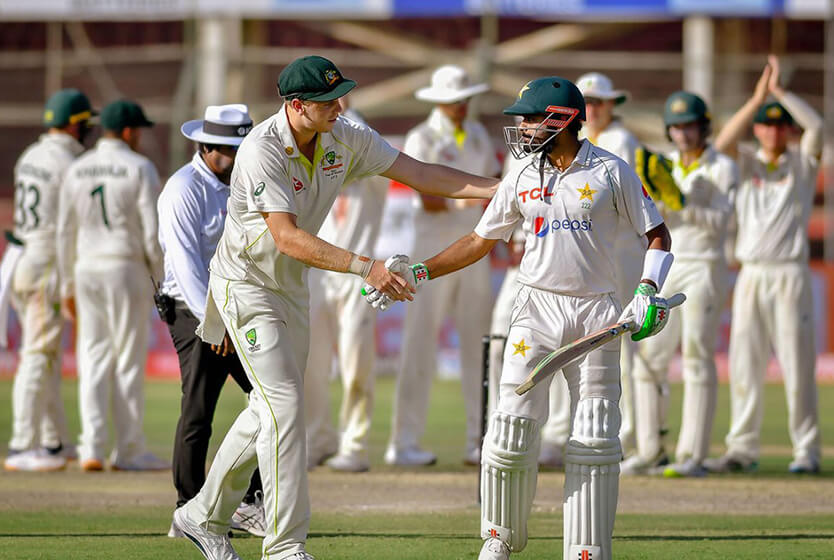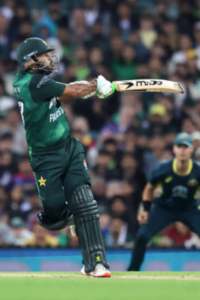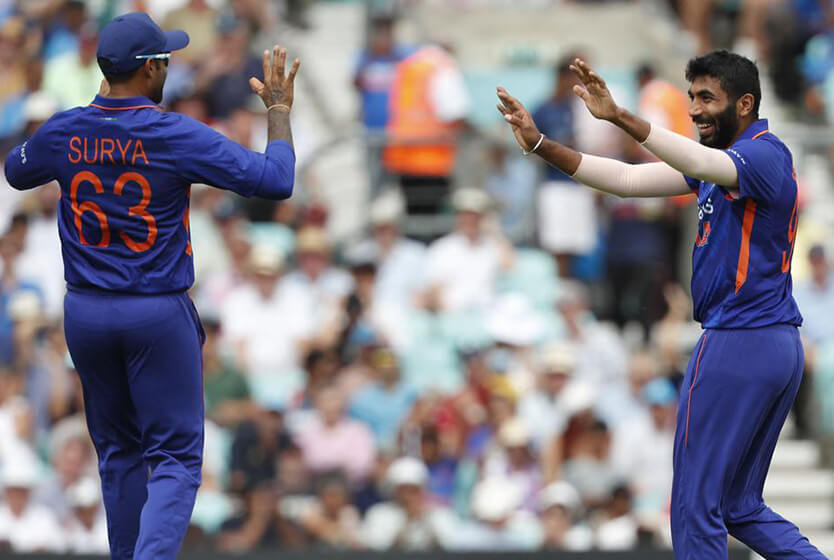
Benaud-Qadir Trophy: Australia vs. Pakistan 2023/24 Preview
Introduction
The second edition of the Benaud-Qadir Trophy starts on 14th December at Perth’s Optus Stadium. Both teams and the fans are looking forward to this tour. For Australia, the first Test is being marketed as the West Test to attract more fans to the newly built Optus Stadium, which has not seen much of a crowd in Tests. This series will also mark the end of David Warner’s Test career, while his former teammate Mitchell Johnson is not happy about the way it is being celebrated because of the sandpaper-gate scandal.
Pakistan is looking towards this series as a start to something fresh – a new team under a new captain, Shan Masood. Since Pakistan’s last tour of Australia, former captain Babar Azam has scored tons of runs, particularly in red-ball cricket. He returns to Australia as a player as he was back in 2019. All eyes will be on him, hoping for even better displays with the bat without the added baggage of captaincy.
Squad
Shan Masood ©, Aamir Jamal, Abdullah Shafique, Abrar Ahmed, Babar Azam, Faheem Ashraf, Hassan Ali, Imam-ul-Haq, Khurram Shehzad, Mir Hamza, Mohammad Rizwan, Mohammad Wasim Jr, Noman Ali, Saim Ayub, Salman Ali Agha, Sarfaraz Ahmed, Saud Shakeel, Shaheen Shah Afridi, Sajid Khan (cover for Abrar Ahmed).
This will be Shan Masood’s first assignment as Test captain, and there will be some questions asked about what can be Pakistan’s best XI for the first Test in Perth.
Top Order
With Shan Masood being captain, his place at number 3 is confirmed. He has batted in this position in the last few Tests after Azhar Ali’s retirement. From the looks of the practice match against the Prime Minister XI and Shan Masood’s indications, Pakistan will go with the experienced opening pair of Abdullah Shafique and Imam-ul-Haq, as expected.
Another option for the opening slot is Saim Ayub, who recently starred in the Quaid-e-Azam Trophy, including a double-century and a century in the final. Despite only playing four games in the tournament, Saim scored 553 runs at an average of 79.
Another reason why Saim is in consideration is that Imam-ul-Haq is known to have a weakness against the short ball and also struggles against new-ball movement. The first Test is in Perth, which has a reputation for being a very fast wicket – with the pace and bounce likely to trouble Pakistan’s batsmen. However, Saim’s selection (for now) looks to be developmental rather than him being thrown into the deep end in Australia.
Middle Order
Batting Composition
Australia’s bowling attack will feature just one spinner in Nathan Lyon, who is returning from injury, with pace bowlers bowling a large percentage of the overs as usual. Pakistan’s three main choices for the middle order are Saud Shakeel, Sarfaraz Ahmed, and Salman Ali Agha.
All three of these batsmen are known for their skill against spin and played a crucial role in some of Pakistan’s recent performances in Asia. However, only Sarfaraz among them has played Tests outside Asia before, and it remains to be seen how they handle the pace and bounce in Australia.
Wicket-keeper
There are two wicket-keepers in this squad, Mohammad Rizwan and Sarfaraz Ahmed. Sarfaraz seems likely to start in Perth on the back of a successful Quaid-e-Azam Trophy, where he was the winning captain and the second-highest run-scorer. Sarfaraz was also the first-choice wicket-keeper in Pakistan’s most recent series against New Zealand and Sri Lanka, after a brief run of poor form for Rizwan saw him relegated to the bench. However, Sarfaraz got concussed in the Sri Lanka series and played only one Test, with Rizwan making a half-century in the 2nd Test after replacing him.
Sarfaraz, as mentioned earlier, is known for his batting abilities against spin and has an impeccable record in Asia, while Rizwan seems better suited for batting in Australia because of his ability to play fast bowling and his backfoot game. On Pakistan’s last tour to Australia, Rizwan scored 177 runs at an average of 44, including an innings of 95 at the Gabba.
Another aspect to keep in consideration is the age factor. Sarfaraz is now 36 years old, and his keeping has regressed with age, as seen repeatedly since his comeback. Despite scoring a truckload of runs against New Zealand in the home series, Sarfaraz missed stumpings, dropped catches, and didn’t appeal on occasion, which hugely cost Pakistan. Wicket-keeping is one of the most demanding things in cricket, and there are only a handful of wicket-keepers who have performed at a high level into their last 30s. On the other hand, Mohammad Rizwan is known to be one of the best glovesmen in the international arena right now and is probably better suited as both a batter and wicket-keeper.
All-Rounder
Faheem Ashraf’s best format is arguably Test cricket. He has performed with the bat and has performed a holding role with the ball pretty nicely as well. There has not been a single Test where he didn’t contribute in either department. His fifties down the order away from home in the West Indies and New Zealand have been instrumental. He has performed in home conditions as well, against South Africa in 2021. Despite this, he was sidelined from the Test squad. But he remains the only option in the country for someone who can reliably bat at number 7 and bowl seam, and as expected, he is back in the squad for Australia, where a four-man pace attack will almost certainly be required.
This year, Faheem captained his side to the Quaid-e-Azam Trophy final and was the best all-rounder in the tournament. He had the 2nd-most runs and 3rd-most wickets from his team. He scored a knock for the ages in the final, but his innings of 147 wasn’t enough to save his team. Overall, he finished the tournament with a batting average of 41 and a bowling average of 25 and was surely one of the best players this season.
If Faheem plays at 7 as expected, that will mean that the Player of the Series against Sri Lanka – Salman Ali Agha – will have to take up drinks duties, understandably so considering the team composition requires a four-man pace attack.
Bowling Attack
Composition
With Abrar Ahmed out of the first Test, it will be a choice between an all-pace attack or an attack of 3 front-line pacers, an all-rounder, and Nauman Ali/Sajid Khan. Another option can be to bowl overs of spin from Saud and Agha while fielding four proper pacers and no Faheem Ashraf.
Pakistan’s poor record in Australia has often been down to their inability to take wickets regularly or even threaten to pick up 20 wickets in a match. The bowling attack will once again be severely tested.
Pakistan’s pace attack remains relatively inexperienced. This is only the second tour of Australia for attack leader Shaheen Shah Afridi, while Hassan Ali, who is likely to be included in the XI, will play his first Test Down Under.
Khurram Shehzad earned his selection after topping the Quaid-e-Azam Trophy wicket-taking charts this year. He is also fairly experienced in red-ball cricket, with 136 wickets in 45 games. Another seam option in the squad is the extremely experienced Mir Hamza. He has yet to succeed at the Test level but has extensive First Class success. Playing either of these two, along with Shaheen Shah Afridi and Hassan Ali together, could mean a one-dimensional attack, with none of them being primed for an enforcer-type role.
Enforcer Role/All-Pace Attack?
Another question regarding the fast bowling attack would be to choose between Mohammad Wasim Jr or Aamir Jamal if Pakistan opt for an all-pace attack. Wasim Jr has been great for Pakistan in white-ball cricket. However, he has not played much red-ball cricket, and the small sample size of his red-ball cricket doesn’t have any standout performances. In the two Tests he has played, his bowling average is in the triple figures.
Aamir Jamal, meanwhile, is experienced in First Class cricket. However, his bowling statistics aren’t too different to Wasim Jr. Both of them have a bowling average in the early 30s in First Class cricket. Jamal only played four games in this year’s Quaid-e-Azam Trophy because of a clash with the Asian Games, but he was still his team’s second-best bowler. He has a reputation for being somewhat wayward with the ball, as reflected in his high economy rate. But the same applies to Wasim Jr.
Spin Options
Sajid Khan has been called up as a backup for Abrar Ahmed. Sajid is quite experienced in First Class cricket. He even played for Somerset last year in the County Championship. However, he had a horrid time with the ball there, picking up only 5 wickets in 6 innings. But he had a decent time with the bat, including a 53* (64) against a Warwickshire bowling attack that featured Mohammad Siraj and Jayant Yadav. He did well in the Quaid-e-Azam Trophy, being the 2nd-highest wicket-taker for Peshawar with 18 wickets in 6 games. He was the fourth-most successful spinner in this year’s Quaid-e-Azam Trophy. Zahid Mahmood, one spot above him, had a worse average.
Nauman Ali is the other spin option Shan Masood will have at his disposal. He had success in Pakistan’s last tour of Sri Lanka, but Pakistan’s team management may be wary of selecting a left-arm orthodox spinner to hold an end, considering Australi’s lineup will feature aggressive left-handers in the form of David Warner and Travis Head.
Conclusion
Shaheen Afridi, who came to Australia as a newbie in 2019, will be eager to make an impression and enhance his Test reputation. This will also be Babar Azam’s first series since giving up captaincy – as the linchpin of Pakistan’s batting lineup, expectations will be high from him.
Meanwhile, quite a few of the batsmen are playing their first series outside Asian conditions, like Saud Shakeel and Abdullah Shafique. This, combined with Pakistan’s new-look bowling attack – already depleted by the injury to Naseem Shah and now Abrar Ahmed missing at least the first Test – means that Pakistan would do well to avoid a series whitewash.
However, Pakistan must approach the series positively and at least compete and give the Aussies a tough time – unlike the disaster of 2019, which featured two innings losses. The pre-series talk has been on the right note, but that’s the easy part. Now, it’s time to back it up with action on the pitch, and that’s where the struggle will start.








Leave a Reply